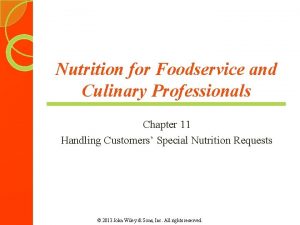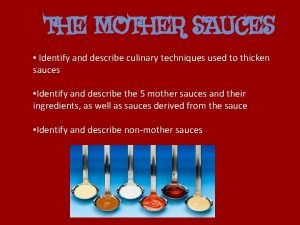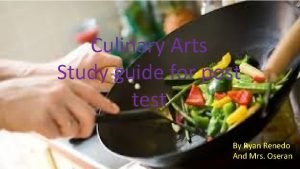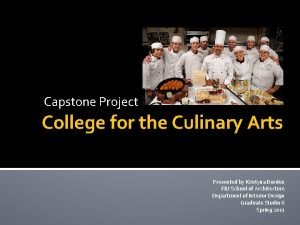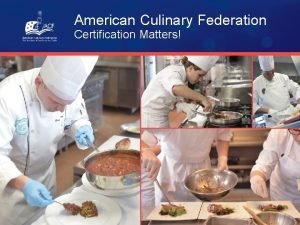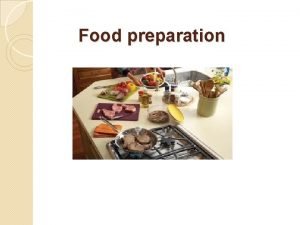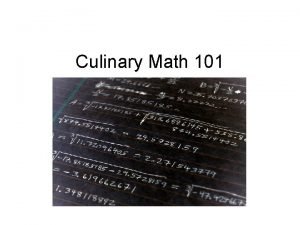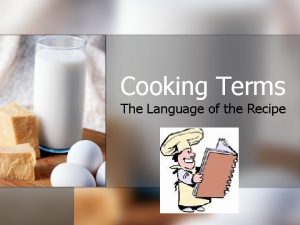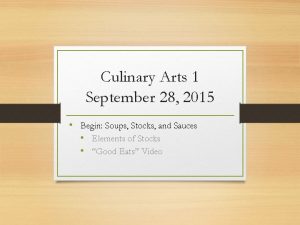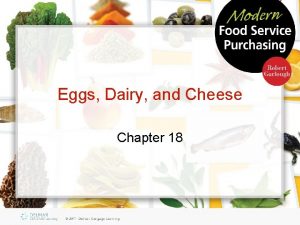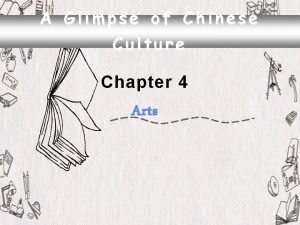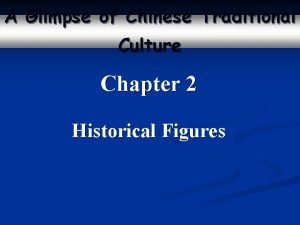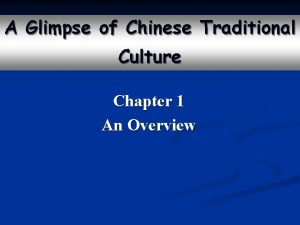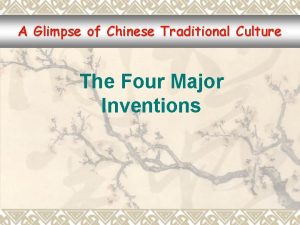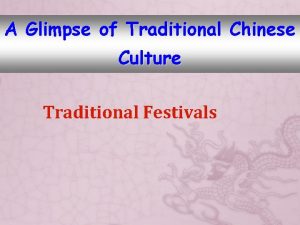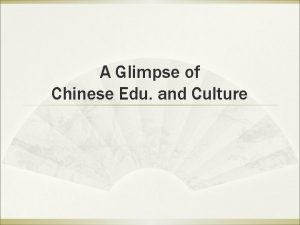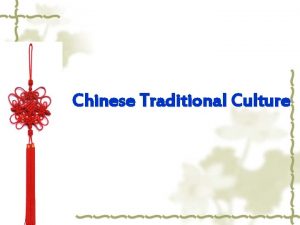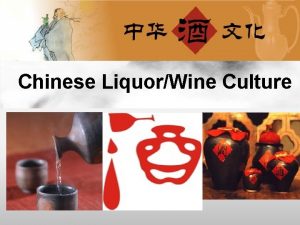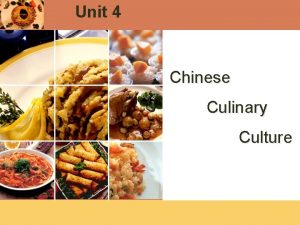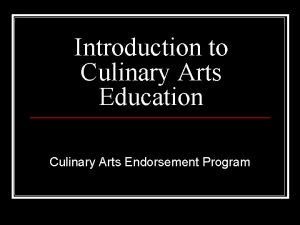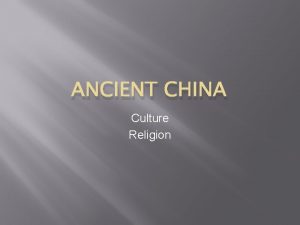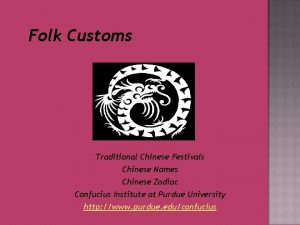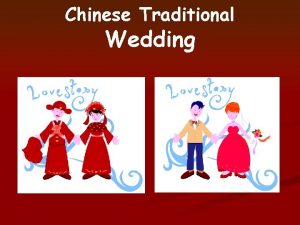A Glimpse of Chinese Culture Chapter 8 Culinary



![The features of Chinese Dishes n Colour, Aroma [əˈrəʊmə], and Taste Colour refers not The features of Chinese Dishes n Colour, Aroma [əˈrəʊmə], and Taste Colour refers not](https://slidetodoc.com/presentation_image_h/cf18862e608fbc030f8b1a3d52eea72a/image-4.jpg)



















![double-stewed soup 老火靓汤 Steamed turtle with chive [tʃaɪv] 香葱sauce 美味蒸甲鱼 roast piglet 烤乳猪 Steamed double-stewed soup 老火靓汤 Steamed turtle with chive [tʃaɪv] 香葱sauce 美味蒸甲鱼 roast piglet 烤乳猪 Steamed](https://slidetodoc.com/presentation_image_h/cf18862e608fbc030f8b1a3d52eea72a/image-24.jpg)






![n n Serving courses Serving order is from cold to hot. Hot entrees[ˈɒntreɪ] (主菜) n n Serving courses Serving order is from cold to hot. Hot entrees[ˈɒntreɪ] (主菜)](https://slidetodoc.com/presentation_image_h/cf18862e608fbc030f8b1a3d52eea72a/image-31.jpg)




















![Drinkers’ Wager [ˈweɪdʒə(r)] Game 酒令 n Drinkers’ wager game is a particular method in Drinkers’ Wager [ˈweɪdʒə(r)] Game 酒令 n Drinkers’ wager game is a particular method in](https://slidetodoc.com/presentation_image_h/cf18862e608fbc030f8b1a3d52eea72a/image-52.jpg)















- Slides: 67

A Glimpse of Chinese Culture Chapter 8 Culinary Culture Nailin Chen School of Foreign Languages and Cultures Jiangsu Second Normal University nailinc@126. com

Ø 1. Chinese Dishes Ø 2. Chinese Tea Ø 3. Chinese Wine

Chinese Dishes n n n The Features of Chinese dishes Eight Regional Cuisines Table Manners
![The features of Chinese Dishes n Colour Aroma əˈrəʊmə and Taste Colour refers not The features of Chinese Dishes n Colour, Aroma [əˈrəʊmə], and Taste Colour refers not](https://slidetodoc.com/presentation_image_h/cf18862e608fbc030f8b1a3d52eea72a/image-4.jpg)
The features of Chinese Dishes n Colour, Aroma [əˈrəʊmə], and Taste Colour refers not only to the beautiful color of the food, but also to the layout and design. n Aroma refers to the fragrant and appetizing smell of the dishes served on the table before eating. n Taste is not only associated with tasting the food itself, but also with the appreciation of seasonings and texture. n


n Cooking Methods n Locality and climate play an important role in cooking. n They include boiling (煮), stewing [‘stju: ɪŋ] (煲/炖/煨/焖), frying (煎), stir-frying (炒), quick-frying (爆), deep-frying (炸), frying and simmering (扒), sautéing [soʊˈteɪ] (快 煎), smoking (熏), roasting or barbecuing ( 烤), baking (烘), steaming (蒸) , scalding (白 灼), etc.

n Seasonings调味品; 佐料 Taste mainly depends on the seasonings. n There are many tastes—salty (salt, soy sauce), sweet (sugar, honey), sour (vinegar), fragrant (sesame oil香油, coriander [ˌkɒriˈændə(r)]香菜, wine), spicy ( 麻的) (chilli, garlic, ginger) , tangy ['tæŋɪ]味 道浓烈的(monosodium glutamate or MSG 味精) , bitter (dried tangerine 陈皮, bitter apricot kernel 苦杏仁), etc. n

n Yin-yang Principle n Each food has its own characteristics of yin or yang. Yin foods are thin, cold and low in calories. Yang foods are rich, spicy, hot and high in calories. Boiling makes food yin; frying makes food yang.

n Medicinal Function In China, people contend主张that a food tonic (食补) is much better than a medicine in fortifying one's health. n Based on traditional Chinese herbal medicine practice, medicinal cuisine combines strictly processed traditional Chinese medicine with traditional culinary (烹饪的) materials to produce delicious food with health-restoring qualities. n

Eight Regional Cuisines n Foods vary from north to south. Tastes also differ regionally because of the climatic differences. One popular summary of Chinese food is “sweet in the south, salty in the north, sour in the west and spicy in the east”.

n Shandong Cuisine, also known as Lu Cai, is characterized by its emphasis on aroma, freshness, crispness and tenderness and the use of minimal fat. Seasonings such as sauce paste 酱, onion and garlic are frequently used so Shandong dishes usually taste pungent. Soups are given much emphasis. Thin soups are clear and fresh while creamy soups are thick and full-flavoured.

Dezhou stewed chicken Yellow River carp in sweet and sour sauce 糖醋黄河鲤鱼 德州扒鸡 braised sea slug with crab meat in brown sauce 蟹烧海参 bird’s nest soup 燕窝汤

n n Jiangsu Cuisine, also known as Su Cai, is acclaimed for its distinctive style and characteristically sweet taste. It preserves the food’s original flavour, while emphasising the strict selection of ingredients, exquisite workmanship, and elegant shapes.

Jinglin salted dried duck 金陵盐水鸭 clear crab and pork meatballs 清炖蟹肉狮子头 yincai cooked with chicken slices银 菜鸡丝 triple combo duck 三套鸭

n Zhejiang Cuisine, or Zhe Cai, has won a reputation for its freshness, tenderness, softness, and smoothness with mellow fragrance. With their elegant presentation, the dishes are a pleasure to the eyes and a comfort for the stomach.

beggar’s chicken 叫花鸡 Dongpo pork 东坡肉 West Lake fish in vinegar shelled shrimps cooked with longjing tea leaves 龙井虾仁 sauce西湖醋鱼

n n Anhui Cuisine, also known as Hui Cai, is highly distinctive not only for its elaborate choices of cooking ingredients but also for its strict control of the cooking process. Anhui chefs pay great attention to taste, colour and cooking temperatures. They are particularly skilled at braising and stewing and experts in cooking delicacies from the mountain and the sea.

stewed soft-shell turtle with ham火腿炖甲鱼 crisp pork with pine nuts 松子米酥肉 Huangshan braised pigeon 黄山炖鸽 Li Hongzhang hotchpotch 李鸿章大杂烩

Sichuan Cuisine, also known as Chuan Cai, is famous for being spicy and flavourful. n Sichuan Cuisine emphasises the use of chili, pepper胡椒, prickly ash花椒, garlic, ginger and fermented soybean 豆豉. The basic cooking methods included frying, frying without oil, braising, etc. n

Mar-boh tofu 麻婆豆腐 hot pot 火锅 fish-flavoured pork shreds 鱼香肉丝 twice-cooked pork 回锅肉 spicy diced chicken with peanuts 宫保鸡丁

n n n Hunan Cuisine, also known as Xiang Cai, is akin 相似的to that of the chili-rich Sichuan dishes. It is also characterised by a dense pungent flavor. Chili, pepper and shallot [ʃəˈlɒt]青葱are necessities in this cuisine. Hunan Cuisine is characterised by hot and sour flavor, fresh aroma, greasiness, deep colour, etc. The local people eat hot peppers to help fight dampness and cold.

Dong’an chicken 东安子鸡 Steamed fried pork in black bean sauce走油豆豉扣肉 peppery and hot chicken 麻辣子鸡 braised dried pork with eel slices腊肉焖鳝片

n Guangdong Cuisine is known as Yue Cai (粤菜). Cantonese are known to have an adventurous palate [ˈpælət] 味觉and dare eat many different kinds of meat and vegetable. Various unusual materials are used for their dishes. Guangdong dishes are fresh, crisp, tender, and lightly seasoned. Steaming and stirfrying are most commonly used cooking methods to preserve the ingredients’ natural flavours.
![doublestewed soup 老火靓汤 Steamed turtle with chive tʃaɪv 香葱sauce 美味蒸甲鱼 roast piglet 烤乳猪 Steamed double-stewed soup 老火靓汤 Steamed turtle with chive [tʃaɪv] 香葱sauce 美味蒸甲鱼 roast piglet 烤乳猪 Steamed](https://slidetodoc.com/presentation_image_h/cf18862e608fbc030f8b1a3d52eea72a/image-24.jpg)
double-stewed soup 老火靓汤 Steamed turtle with chive [tʃaɪv] 香葱sauce 美味蒸甲鱼 roast piglet 烤乳猪 Steamed sea bass[beɪs] 蒸海鲈鱼

n Fujian Cuisine, also known as Min Cai, is noted for its light taste and sweet and sour flavour. It has the characteristic of strictly selected ingredients, and is thus particularly apt in preparing seafood dishes. fried prawn shaped as a pair of fish 太极明 虾 crisp pomfret ['pɒmfrɪt] with litchi 荔枝鲳鱼 pork roll with rice flour steamed in lotus leaf 荷叶米粉肉

A Bite of China is a documentary television programme produced by CCTV. The programme is intended to familiarize people around the world with Chinese food culture, local customs, and the great Chinese heritage through different cuisines form different regions. It introduces the history and stories behind food in different locations in China.

Table Manners n n Arrangement of seats At a formal banquet, the host prepares adequate seating for the guests. For a large number of guests, the elderly or people of high status are allocated specific seats. Special guests and the elderly sit on the north side of the table or directly facing the entrance to the room. The concept of “honoured south, humble north” is closely related with traditional Chinese etiquette.


n n n Toasts Once the guests are seated, the host proposes a toast to the guests whilst saying, “Drink first to show respect”(先干为敬). Then the host and guests empty their glasses, which are refilled in readiness for the next of many toasts. It is perfectly acceptable to have three toasts (traditionally signifying friendship) with the entire company, rather than one separate toast for every individual present. Some other toasts can be offered: “Toast for your health”, “Toast

![n n Serving courses Serving order is from cold to hot Hot entreesˈɒntreɪ 主菜 n n Serving courses Serving order is from cold to hot. Hot entrees[ˈɒntreɪ] (主菜)](https://slidetodoc.com/presentation_image_h/cf18862e608fbc030f8b1a3d52eea72a/image-31.jpg)
n n Serving courses Serving order is from cold to hot. Hot entrees[ˈɒntreɪ] (主菜) should be served starting on the left of the seat across from the main guests. The meal then begins with a set of at least four cold dishes followed by the main courses of hot meat and vegetable dishes. Soup is served next (unless in Guangdong style restaurant) with the local staple food such as rice, noodles and dumplings being served last.


Chinese chopsticks n The correct holding of the chopsticks is to grab the chopsticks in the middle, making sure that the ends are even. n There are some taboos about using chopsticks: 1. Don’t stick your chopsticks upright in the rice bowl (the food is for the dead) 2. Don’t wave chopsticks above the dishes. 3. Don’t tap on your bowl with them (only beggars do so). 4. Avoid sucking the ends of them or keeping them in your mouth for a long time. (never use it as toothpick) 5. Never point at someone with them and do not use them to prick food in order to pick it up. n

Chinese Tea n China has a rich and sophisticated tea culture. The Chinese have a common saying, “Seven things in the house: firewood, rice, oil, salt, soy sauce, vinegar and tea”.

n The art of tea making and drinking evolved through the dynasties. It focuses on the method of brewing tea, the drinking utensils and the serving etiquette.

Tea Classification n The five types are green tea (绿茶), black tea (红茶), oolong tea (乌龙茶), compressed tea (砖茶: brick tea), and scented tea (花茶). Some minor types are white tea and yellow tea. n

Green tea, which is unfermented, is the most natural of all Chinese teas. It’s called green tea because the tea liquid and tea leaves are greenish. Compared with other types of Chinese tea, it has the most medicinal value and the least caffeine content. It can help people reduce their inner heat. Longjing of West Lake西湖龙井, maofeng of Mount Huanghsan黄山 毛峰, biluochun , yunwu fm Mount Lushan庐山云雾

n n Black tea is fermented before baking. It’s so named because the tea liquid and tea leaves are reddish black. It tastes sweet and can facilitate the fostering of yang energy in the human body and erase the greasiness of the stomach. qihong tea of Anhui祁红茶, dianhong tea of Yunnan滇红茶, suhong tea of Jiangsu苏红茶, chuanhong tea of Sichuan 川红 茶and huhong tea of Hunan湖红 茶.

n Oolong tea sits half way between green tea and black tea in the sense that it's halffermented. Typical oolong tea leaves are green in the middle and red on the edges as a result of being softened. Oolong tea is the chosen tea for the famous gong fu tea brewing process. Its aroma ranges from mild to medium. tieguanyin

n Compressed tea is made by compressing steamed tea leaves into molds such as bricks, cakes, columns and other shapes. Most Chinese Compressed tea uses black tea as its base. Compressed tea can be stored for years or even decades. Aged Compressed tea has a gentle flavor.

n Chinese Scented tea is a unique class of Chinese tea. It is a mixture of flowers such as rose, jasmine, orchid [ˈɔrkɪd] 兰花, and plum and tea leaves, mostly green but also with elements of black or oolong tea. The two are finely blended and sealed for a time to let the sweet scent of flowers pervade tea leaves.

n White tea is nonfermented, non-rubbed tea with natural fragrance. Famous varieties include Silver Needle (白毫银珍) and White Peony [ˈpi: əni: ] (白牡丹).

n Yellow Tea has yellow leaves and yellow tea colour. It's an uncommon class of Chinese tea. The flavor is mild and refreshing.

Tea Etiquette n Serving a cup of tea is more than mere politeness. It is a symbol of togetherness, a sharing of something enjoyable, and a way of showing respect to guests. n

n To offer tea, ask for the preference of the guest before making tea. The water should not be too hot or it will scald the guest. When you pour tea, the rule of “full cup for wine and half cup for tea” should be observed. Custom dictates that a host will only fill a teacup to seven -tenths of its capacity. It is said that the other three-tenths will be filled with friendship and affection. When offered tea, the guest should take a sip at least, which is considered polite. Moreover, make sure that the spout壶嘴 of the


Three Cups of Tea (三杯茶) of Bai Ethnic Group n Visitors are greeted with this warm and unique ceremony: they are offered three cups of tea. The first cup of tea, made from local bitter leaves, tastes very bitter. The second , made from walnuts (核桃), cheese and sugar, looks like soup and tastes sweet. The third cup, made by mixing prickly ash美洲花 椒, ginger and cinnamon (肉桂) with honey and bitter tea, is pungent, with a distinct aftertaste.

What does the three cups of tea symbolize? n The three cups of tea are symbolic of the three stages of one’s life journey: going through all kinds of hardships, exploring the joy of life, and recalling both bitter and happy experience. (先苦 后甜三回味)

Chinese Wine n Wine has a long history in China and plays an important part in the life of Chinese people. It is comparable with such daily necessities as rice, salt, oil and water.

n Wine Feasts “Marriage wine feasts” n “Arm-crossed wine” n “Month-old wine feasts” n “Hundredth-day wine feasts” n “Longevity wine feasts” n “Beam-placed-on-the-roof wine feast” n “moving-into-a-new-house wine feast” n A feast for opening a business n A feast for division of dividends 分红宴 n A feast for farewell n …. . n

Chinese New Year’s Eve : New Year’s wine, wishing good health and closeness in the family in the coming year. Dragon Boat Festival: realgar wine雄黄酒, changpu wine 菖蒲酒to ward off evil spirits and hope for peace and security. Mid-Autumn Festival: osmanthus wine 桂花酒 Double Ninth Festival: chrysanthemum wine 菊花酒
![Drinkers Wager ˈweɪdʒər Game 酒令 n Drinkers wager game is a particular method in Drinkers’ Wager [ˈweɪdʒə(r)] Game 酒令 n Drinkers’ wager game is a particular method in](https://slidetodoc.com/presentation_image_h/cf18862e608fbc030f8b1a3d52eea72a/image-52.jpg)
Drinkers’ Wager [ˈweɪdʒə(r)] Game 酒令 n Drinkers’ wager game is a particular method in China to help create more joyous atmosphere while drinking. In general, the drinkers’ wager game is used as a penalty to urge drinkers to drink more, but the chief purpose of the drinkers’ wager game is to create a more cheerful atmosphere. n

n n General games Ladies attending banquets may play general games such as telling jokes, solving riddles and passing down a flower to the beats of a drum (击鼓传花).

n Literary games are more popular with scholars and intellectuals, since their education equips them with the knowledge to compete. They play it by composing poems, solving word puzzles and guessing riddles.

n Competing game Archery, arrow pitching, dice throwing (掷骰子) and finger guessing are competing games.

Alcohol and Social Activities n Alcohol and Arts n Alcohol drinks, more than any other beverages, has had a great impact on Chinese artists as it seems that many of them have produced their best masterpieces in a state of drunkenness. Many famous poets such as Li Bai and Du Fu were fond of drinking wine.


Alcohol and Business n In China, alcohol plays an integral必须 的role in social life. Drinking effectively serves to deepen and strengthen the bonds of friendship. Drinking is always used as a way to relieve misunderstanding and animosity [ˌænɪˈmɒsəti]敌意no matter how tense the situation is. n

Alcohol and Health n Chinese people believe that moderate drinking is good for their health. Many Chinese do sip a little alcohol periodically to maintain their vitality 活 力and health. Some even soak traditional Chinese medicine in liquor to achieve a better effect. n

Exercises I Complete the following table: Eight Regional Cuisines Food Features Typical Dishes Shandong Cuisine characterised by its emphasis on aroma, freshness, crispness and tenderness and the use of minimal fat, tasting pungent the Yellow River carp in sweet and sour sauce, bird’s nest soup, braised sea slug with crab meat in brown sauce, Dezhou stewed chicken Sichuan Cuisine spicy and flavourful hot pot, twice-cooked pork, spicy diced chicken with peanuts, fish-flavoured pork shreds and mar-boh tofu Guangdong Cuisine fresh, crisp, tender and lightly seasoned, unusual cooking materials Double-stewed soup, steamed sea bass, roast piglet, steamed turtle with chive sauce

Exercises I Complete the following table: Eight Regional Cuisines Food Features Typical Dishes Fujian Cuisine noted for its light taste, and sweet and sour flavour crisp pomfret with litchi, pork roll with rice flour steamed in lotus leaf, fried prawn shaped as a pair of fish Jiangsu Cuisine acclaimed for its distinctive style and characteristically sweet taste, strict selection of ingredients, exquisite workmanship and elegant shapes Jinling salted dried duck, clear crab and pork meatballs, yincai cooked with chicken slices, triple combo duck Zhejiang Cuisine fresh, tender, soft, smooth, Beggar’s chicken, fragrant, carefully selected Dongpo pork, West Lake and prepared ingredients fish in vinegar sauce, shelled shrimps cooked with longjing tea leaves

Exercises I Complete the following table: Eight Regional Cuisines Food Features Typical Dishes Anhui Cuisine elaborate selection of cooking, ingredients and strict control of the cooking process, slightly spicy and salty stewed soft-shell turtle with ham, Huangshan braised pigeon, crisp pork with pine nuts, Li Hongzhang hotchpotch Hunan Cuisine characterised by hot and sour flavour, fresh aroma, greasiness, and deep colour Dong’an chicken, peppery and hot chicken, steamed fried pork in black bean sauce, braised dried pork with eel slices

Exercises I Fill in the blanks: 1. Generally speaking, there are three essential factors by which Chinese cooking is judged, namely color , aroma and taste. With taste being the most important. 2. At a formal banquet, the host prepares adequate seating for the guests. the elderly and people of high status sit at the north side of the table or directly facing the entrance to the room. The concept of “honored south, humble north” is closely related with Chinese traditional etiquette 3. Chinese tea can be classified into five basic categories according to their different processing techniques. The five types are green tea , black tea , oolong tea, compressed tea and scented tea. Some miner types are white tea and yellow tea. 4. The drinkers’ wager game has many forms, depending on the drinker’ social status, literacy status, and interest. Generally, there are three categories: general games, literary games and competing games.

Exercises Part Two Translation Term Translation: 1. 八大菜系 eight regional cuisines 2. 老火靓汤 double-stewed soup 3. 《舌尖上的中国》 A Bite of China 4. 乌龙茶 oolong tea 5. 交杯酒 arm-crossed wine

Exercises Passage Translation: 中国有句老话,“民以食为天。”可见饮食在中国人生活中的分量。中 国地域辽阔,由于各地气候、物产以及风俗习惯的差异,形成了以鲁菜、 川菜、粤菜、闽菜、苏菜、浙菜、徽菜、湘菜为代表的八大菜系。中国 菜讲究色、香、味,其中尤以位最为重要。中国的菜名五花八门,著名 菜肴的名称背后都有段生动地故事,这为中国饮食文化平添了几分神秘 色彩。 There is an old saying in China, “food is what matters most to people. ” It illustrates the significant role food plays in the life of Chinese people. As a vast country with diverse climates, products, and customs, China is known to have eight regional cuisines which include Shandong, Sichuan, Guangdong, Fujian, Jiangsu, Zhejiang, Anhui, and Hunan cuisines. There are three essential standards by which Chinese cooking is judged, namely, colour, aroma, and taste, with taste being the most important. The names of Chinese dishes are many and various. There are interesting stories behind the names of famous Chinese dishes, which add to the mystique of Chinese food culture.

Chapter 8 Culinary Culture Further exploration: Download A Bite of China (a documentary television program produced by CCTV) to know more about Chinese food culture, local customs and the great Chinese heritage.

Nailin Chen School of Foreign Languages and Cultures Jiangsu Second Normal University nailinc@126. com
 Anglo chinese school
Anglo chinese school Chapter 11 culinary nutrition
Chapter 11 culinary nutrition Chapter 4 becoming a culinary professional answers
Chapter 4 becoming a culinary professional answers Culinary nutrition definition
Culinary nutrition definition Chapter 14 culinary math
Chapter 14 culinary math Vce chinese language culture and society
Vce chinese language culture and society Spicet chart
Spicet chart Material culture examples
Material culture examples Individual culture traits combine to form culture patterns.
Individual culture traits combine to form culture patterns. Batch culture vs continuous culture
Batch culture vs continuous culture Continuous culture and batch culture
Continuous culture and batch culture Individualistic culture definition
Individualistic culture definition Difference between american culture and indian culture
Difference between american culture and indian culture Stab culture and stroke culture
Stab culture and stroke culture Folk culture and popular culture venn diagram
Folk culture and popular culture venn diagram A sub-culture group
A sub-culture group Leisure
Leisure Site:slidetodoc.com
Site:slidetodoc.com Homework due today
Homework due today Adaptive culture from inert culture
Adaptive culture from inert culture Carpet culture method
Carpet culture method Robertson cooked meat medium
Robertson cooked meat medium Laying the foundation for a quality culture
Laying the foundation for a quality culture Surface culture deep culture and esol
Surface culture deep culture and esol Mandoline definition
Mandoline definition Chef culinary conference
Chef culinary conference Mother sauces
Mother sauces Conversion factor recipe
Conversion factor recipe Nutrition for foodservice and culinary professionals
Nutrition for foodservice and culinary professionals Los angeles harbor college class schedule
Los angeles harbor college class schedule Culinary maths
Culinary maths Culinary school terms
Culinary school terms Culinary outpost
Culinary outpost Culinary arts study guide
Culinary arts study guide Culinary jeopardy
Culinary jeopardy Strand for culinary arts
Strand for culinary arts American culinary federation certification
American culinary federation certification Joint culinary center of excellence
Joint culinary center of excellence Crosshatch markings culinary
Crosshatch markings culinary Prepare food definition
Prepare food definition Culinary crossword 2.1 fire safety
Culinary crossword 2.1 fire safety Culinary math
Culinary math Rondelle definition cooking
Rondelle definition cooking Fat tom culinary definition
Fat tom culinary definition Culinary
Culinary Standardized recipe format
Standardized recipe format Dasar dasar kuliner
Dasar dasar kuliner Language
Language Culinary school in thailand for international students
Culinary school in thailand for international students Crosshatch marks culinary definition
Crosshatch marks culinary definition Coast guard culinary school
Coast guard culinary school International cooking a culinary journey
International cooking a culinary journey What is fattom
What is fattom Look at each picture
Look at each picture Caravan on the move
Caravan on the move Degrease culinary definition
Degrease culinary definition Barding culinary definition
Barding culinary definition Nutrition for foodservice and culinary professionals
Nutrition for foodservice and culinary professionals Nutrition for foodservice and culinary professionals
Nutrition for foodservice and culinary professionals Culinary crossword 9.1 eggs and dairy
Culinary crossword 9.1 eggs and dairy Yeast culinary definition
Yeast culinary definition Ksu stingers menu
Ksu stingers menu Culinary arts strand
Culinary arts strand Chapter 28 popular culture in the roaring twenties
Chapter 28 popular culture in the roaring twenties Chapter 8 lesson 1 greek culture
Chapter 8 lesson 1 greek culture Chapter 8 study guide human resources culture and diversity
Chapter 8 study guide human resources culture and diversity Chapter 8 study guide human resources culture and diversity
Chapter 8 study guide human resources culture and diversity Chapter 16 organizational culture
Chapter 16 organizational culture

